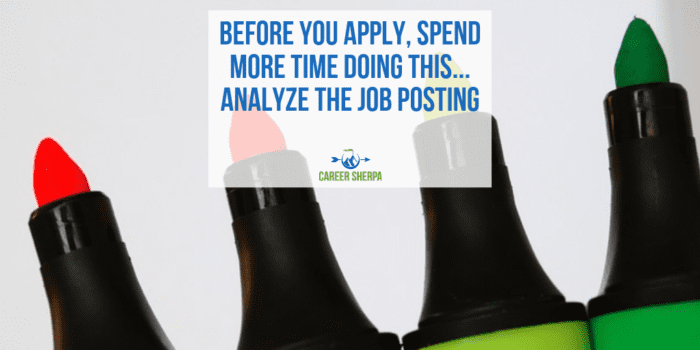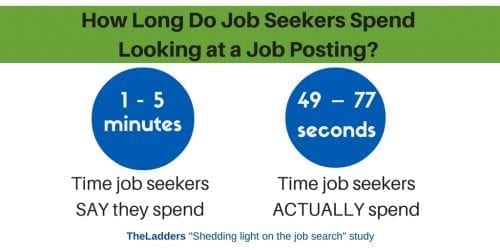The most important thing to do before you apply to any job is to thoroughly analyze the job posting.
You’ll find 8 tips on how to thoroughly analyze a job postings PLUS hear from a marketing expert who writes job postings!
Finding a suitable job posted online is tough. Getting called for a job interview is even tougher. So, before you apply, spend more time doing this – Analyze the job posting.
There you are, sifting through the daily job ads, searching for one that look good enough to apply to, when you find one! Finally, you find the perfect job!
You want to apply quickly so you don’t miss out on the opportunity so you attach your standard, generic resume, hit send and wait. And wait. And wait. Nothing.
This can be frustrating and discouraging. What can you do about it? I’ve got an answer, but you probably won’t like it.
Analyze The Job Posting- Really!
How long do you spend reviewing a job posting to determine if you meet the qualifications and the job and company interest you? Probably not long enough.
44% of job seekers said they spent between one and five minutes reviewing a job posting according to TheLadders’ study. This eye-tracking study analyzed how job seekers read and evaluate job listings.
In reality, 49.2 – 76.7 seconds is how long job seekers actually spent reviewing job postings, according to TheLadders study. That’s not long enough.
Thoroughly Analyze Job Posting
Before you upload your resume and hit submit, stop. Take time to dissect the job posting and verify it’s worth applying for. You never know what information you’ll uncover.
Most job postings are broken into several sections:
- a general overview or summary of the company and the role;
- a key responsibilities section, listing job duties;
- a qualifications section, which includes educational requirements, certifications, years of experience and other skills.
1. Job Titles Can Be Misleading
Skim through the entire job posting and pay attention to the years of experience the position requires.
Years of experience usually equates to the level of the position. One to three years is usually considered entry-level, four to nine years is mid-level and over 10 years usually indicates a senior-level position. This should also help you determine if you are under-qualified or over-qualified. Applying for a job you are over-qualified for is just as bad as applying for a job you are under-qualified for.
2. Understand If You Are A “Fit”
Usually listed at the top of the posting you’ll learn about the company and get basic information about the role. This helps you determine if it’s the right type of job and company for you. While you may not read this section first, definitely go back and read it if the posting seems interesting.
3. Check The Job Duties
You do NOT need experience doing everything the job ad asks for.
You do need to have over 60%.
Review each job responsibility and highlight the things you have already done and want to continue doing. This also helps you modify your resume to address each requirement you meet.
And in case you are wondering, yes, you need to modify your resume for every job you apply to!
4. Do You Meet The Requirements
The requirements sections usually fall near the bottom of the posting. It lists educational requirements, general skills and experience.
Some requirements will be critical or non-negotiable to the employer, some may be flexible, but you won’t know. The only way to know the real answer is to speak with the hiring manager.
Also, be on the lookout for requirements that ask for industry or job-specific experience or whether relevant experience is acceptable.
It’s important to note that not all requirements are truly required!
Identify any requirements you are missing and be ready to explain how you possess other skills or experience that compensate for those you lack. You may choose to use these answers in your cover letter to overcome your missing qualifications. If you are lucky enough to get an interview, you will need to provide these answers then.
5. Accentuate Less-Common Skills
Many applicants will be tossing their hat into the ring for the same jobs you are interested in.
Your application should show how you meet the job requirements plus include information that will knock the employer’s socks off, or at least, get them to notice you. Is there a technology listed as optional that you possess?
Be sure to include these rare skills on your resume and call attention to them in your cover letter by explaining why the skills will benefit your future employer.
6. Read Between the Lines
You may notice some job descriptions sound very generic. The lack of specifics shouldn’t hurt your chances of hitting the mark.
For example, a business analyst job description might state that the candidate should possess “excellent communication skills.” What this really means is that the job will require you to compile your research and analysis into a written summary.
Rather than generically listing “communication skills” on your resume, use the words “report writing” or “written analysis” in your summary and in a bullet under your work experience. Write your bullet so it illustrates an actual example of a time you produced a written summary, for example:
“Conducted industry research and wrote executive summary used to present analysis to senior leadership. Led to entry into new consumer market worth potentially $5 Million in revenue.”
7. Research the Company
Once you determine the job sounds interesting, investigate the company’s products and/or services, learn about its customers and read testimonials. Conduct due diligence before you apply.
Take all these steps:
- ask people in your network about the company
- look for articles written about the company
- check Glassdoor for employee reviews
If you discover news about products, services or industry focus that matches your background, you better make sure you include that in your resume.
The whole idea is to find intelligence that will enable you to convey how you are a match for the role and show you are interested in the company.
8. Show You’re A Match
Researching the role and company helps you customize your resume and cover letter. Your resume must prove you have the specific experience and skills requested.
It is important, in fact, it’s essential, to revise your resume to match the responsibilities you highlighted in the responsibilities section of the job posting. You want your resume to include as many of the job responsibilities as possible, without exaggerating or lying.
Your cover letter should connect the dots and show the reader not only that you meet the qualifications, but you know about the company too.
If you really want to increase your odds of getting an interview, you should get referred! I call it doing the two-step. Learn how to find people who can refer you!
Always Follow Instructions
Read the application’s instructions very carefully. Some companies will toss applicants who do not follow instructions. You never know.
The instructions may direct you to another site, or specify the file format for your resume. And sometimes the company may even instruct you to submit a sample of your work.
The Bottom Line: when you analyze the job posting, you increase your odds of getting looked at.
More Help From A Marketer Who Writes Job Postings
Katrina Kibben, Founder of Three Ears Media, just shared tips for how to analyze a job posting. (I’ve known and respected Katrina for years!)
The reason this is important to watch is because of Katrina’s expertise. Katrina works with HR and recruiters to help them craft better job postings.
This short video covers these topics:
- Researching titles
- What’s Most important
- Watch out for buzzwords
- Memorable messages matter
Watch the video here
This post originally appeared on US News & World Report On Careers

Hannah Morgan speaks and writes about job search and career strategies. She founded CareerSherpa.net to educate professionals on how to maneuver through today’s job search process. Hannah was nominated as a LinkedIn Top Voice in Job Search and Careers and is a regular contributor to US News & World Report. She has been quoted by media outlets, including Forbes, USA Today, Money Magazine, Huffington Post, as well as many other publications. She is also author of The Infographic Resume and co-author of Social Networking for Business Success.


